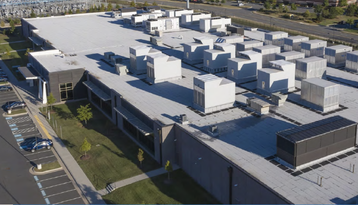Georgia Pacific’s Chris George highlights why cover boards are perfectly positioned (quite literally) to protect your facility from the elements, enhance performance of roof systems and save you money.
To understand the impact roof cover boards can have on flat roof performance, you can also request Georgia-Pacific's CPDs, ‘What are cover boards’ and ‘Roof cover board performance and FM approvals’ here.
Enhancing the performance of data center roof systems
Data center construction has a unique set of challenges, and high demand is placed on the building envelope performance, which includes the roof system.
The building envelope aims to minimize, if not altogether eliminate, the risk of service disruption in the event of severe weather or adverse situations that could have a considerable commercial impact or even damage the expensive equipment within the building.
Specification of fibreglass mat gypsum cover boards helps maintain roof system performance as well as its durability and can help speed up project delivery time. These lightweight cover boards are installed between the insulation layer and the waterproofing membrane.
Once installed, they become an integral part of a flat roof build-up that helps increase the resilience of roof components and the building envelope during and after construction.
Cover boards also serve as a homogenous, compatible substrate for the waterproofing membrane and help enhance the roof and building performance in these areas:
- Waterproof membrane impact and puncture resistance
- Wind uplift
- Fire and acoustic resistance
- Reduced installation time, capital outlay and building running cost.
Impact and puncture resistance provided by a roof performance cover board
Cover boards can offer additional resistance for various components of roof assemblies across most types of roof systems. The strength of the cover board means that the waterproofing roof membrane is more uniformly supported. The cover board also helps shield the traditionally most expensive roofing layer, the insulation.
A cover board acts as a substrate for the installation of a variety of roof coverings and roofing membranes. The flat surface of the cover board helps support the waterproofing membrane from damage caused by foot traffic, accidentally dropped tools, flying debris and similar potential hazards.
The use of a roof cover board offers resistance, to the insulation, from compression caused by heavy equipment that is often housed on data center roofs. This may include heating, cooling, and ventilation (HVAC) units or solar panels installed on the roof.
Cover boards for enhanced wind uplift protection
Due to their vertical pull strength, gypsum core cover boards can help increase the wind uplift resistance of a roof build up. As mentioned in the last section, where the cover boards serve as a homogenous substrate for a waterproofing membrane they can also improve the roof system's performance in extreme storms and windy conditions. The resistance a cover board offers extends to other components of roof build-up, including the structure itself.
In recent years, the increased frequency and force of adverse weather instances in the UK, and Europe, indicate a long-term trend of storms tracking towards this area. Although the installation of cover boards has not been common practice in the UK outside Scotland, this is rapidly changing as the construction industry looks to mitigate the risk of damage to flat roofs from such events.
How do cover boards improve fire and acoustic resistance of a roof build-up?
Due to a material composition that includes 21 percent chemically combined water, high-density gypsum cover boards provide enhanced fire resistance for roof build-ups. Gypsum based cover boards increase the roof's resistance to external fire sources. When installed below the insulation layer, the gypsum board can help stop or slow the spread of an internal fire into the roof space.
Cover boards have a proven track record in sound performance improvements. The DensDeck® Roof Board has been strenuously tested in independent acoustic laboratories to document the performance improvements it can achieve in roof assemblies.
These boards are now widely used for sound attenuation in aviation and leisure buildings, swiftly propagating to application in data centers.
How can the specification of DensDeck® Roof Boards reduce capital outlay and operational building costs?
DensDeck® Roof Boards can achieve data center project cost savings and reduce the operational cost of the data center through several avenues.
- The lifecycle cost of the roof is reduced as the cover board can increase the durability of the roof build-up and help reduce performance issues, maintenance expenditure and costly roof repairs.
- The ease of installation and the lightweight nature of the cover boards mean fewer deliveries, reduced installation time and lower cost of labour.
- As a performance solution, fibreglass mat gypsum cover boards are often more cost-effective to install than other cover board solutions, for example, cementitious boards.
For specification advice and more information on how DensDeck® Roof Boards can benefit your project, contact the experts at Georgia Pacific here.



